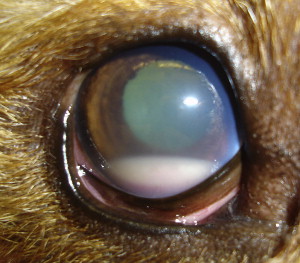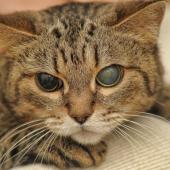Uveitis, eye problem in cats & dogs

Inflammation inside the eye is called uveitis. The iris, or colored portion of the front of the eye, and the choroid, or layer of blood vessels located deep below the eye behind the retina, are the components that are impacted. There are numerous causes of uveitis, a common illness that affects both dogs and cats. If left untreated, uveitis can cause blindness as well as significant eye damage.
Tumors, cataracts, severe corneal ulcers, excessive blood pressure, immune-mediated diseases, some infections, and trauma like being struck by a car are among the eye problems that can result in uveitis. Uveitis can be primary or secondary.
Uveitis is a secondary symptom in various eye and body-wide diseases, and it manifests as a similar condition in many eye ailments. Your veterinarian will perform a thorough examination of your eyes, which will involve examining the back of your eyes using an ophthalmoscope. A tonometer will be used to assess intraocular pressure in the event that glaucoma or uveitis is suspected. The intraocular pressure is lower than usual in the early stages of uveitis, but if the condition progresses, it can lead to glaucoma, where the pressure is excessively high.
Tests and pressures aid in identifying the specific type of uveitis in a dog or cat, providing a more precise understanding of available options for treatment and the likelihood of recovery (prognosis).
In order to determine the underlying reason of your pet's uveitis, your veterinarian will likely utilize additional diagnostic tests if the cause isn't immediately apparent, including trauma, an intraocular tumor, or a cataract. There are numerous infectious disorders that can be identified by blood testing. X-rays of the chest or abdomen may be necessary to check for malignancies or indications of fungal illnesses.
When an ophthalmoscope cannot be used to examine the eye thoroughly due to cloudiness, an ultrasound examination of the eye may be advised to screen for foreign bodies or traumatic rupture of the eyeball.
CAUSES
Noninfectious Causes of Uveitis
- Idiopathic Uveitis
Lens-Induced Uveitis. the damage start from the lens - Trauma
Blunt trauma and penetrating trauma can incite uveitis and are common causes of uveitis in domestic animals - Golden Retriever Pigmentary Uveitis
Primarily reported in the golden retriever, pigmentary uveitis is characterized by anterior segment inflammation and the deposition of pigment on the anterior lens capsule, often in a radial fashion. - Uveodermatologic Syndrome
or Vogt-Koyanagi-Harada-like syndrome, is an autoimmune condition of dogs in which melanocytes become the target of the cellular response - Neoplasia-Associated Uveitis
Infectious Causes of Uveitis
- Brucella canis
- Tick-Borne Diseases
Borrelia burgdorferi (Lyme disease), Ehrlichia spp, including canis, platys, and risticii, and Rickettsia rickettsii (Rocky Mountain spotted fever /RMSF) - Leptospirosis
- Systemic Mycoses
Blastomycosis, cryptococcosis, coccidiomycosis, and histoplasmosis - Feline infectious peritonitis, also known as FIP (viral)
- Feline immunodeficiency virus, also known as FIV (viral)
- Toxoplasmosis (parasitic)
Immune-mediated causes
- Drug reactions
- Vaccine reactions
- Toxins
- Other systemic disease processes
CAN UVEITIS BE CURED ?
The prognosis, or long-term outlook, for uveitis varies based on the underlying etiology. A dog or cat with uveitis may either recover considerably and fully from these infections, or they may become life-threatening if treatment is not received, as is the case with certain of the systemic infections linked to uveitis. The likelihood that uveitis brought on by trauma or another treatable condition will resolve without causing significant harm to the eye depends on how severe the inflammation is; some patients recover completely and regain normal comfort and vision, while others are left with some degree of complications like cataracts, glaucoma, blindness, or a shrunken eye.
TREATMENT & MANAGEMENT UVEITIS
To protect the eye, uveitis must be treated quickly and aggressively. If at all feasible, the underlying illness that is causing the uveitis needs to be managed. Severe instances might first need to be treated in a hospital. Anti-inflammatory medications are used to manage ocular inflammation. The most commonly utilized pharmaceuticals are corticosteroids, or substances that resemble cortisone. These could be prescribed as eye drops or eye ointments (applied to the eye multiple times per day), depending on the underlying cause and severity of the condition.
Corticosteroids and immunosuppressive medications may occasionally be taken orally as pills. Atropine eye drops or ointment may be recommended to avoid further changes in the eye brought on by the uveitis and to lessen pain. Since the tissues in the eyes frequently take a while to heal, uveitis treatment usually requires a minimum of two months.
DOs:
- After administering eye drops or ointments to your pet, make sure you properly wash your hands. This is particularly crucial while taking antibiotics, which can cause serious allergic reactions in vulnerable individuals, and atropine drugs, which will cause your pupils to dilate if you accidently get them in your eyes.
- Monitor your cat's or dog's visual symptoms. The optimum course of treatment is usually determined by the trend over a few days to weeks, as daily changes are normal. • For a professional evaluation by a veterinary eye specialist, consider referring the patient to a veterinary ophthalmologist (www.acvo.org).
DON'Ts:
- Never stop taking medication before your veterinarian has instructed you to. Treatment is required for several weeks to fully control the problem, even though the eye appears improved.
VETERINARIAN CALL
- In the event that you are unable to use eye medicine as prescribed.
- If there are changes to the eye's appearance.
WATCHOUT
- Some cats may experience vomiting or salivation when exposed to atropine. Get in touch with your veterinarian if this happens.




